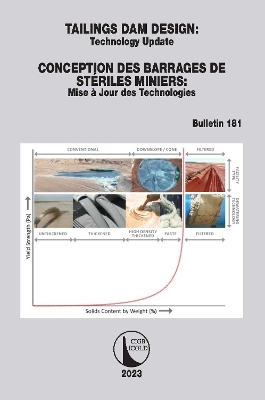
Tailings Dam Design / Conception des Barrages de Stériles Miniers
CRC Press (Verlag)
978-0-367-77046-4 (ISBN)
Tailings are produced from the processing of mineral ores and are commonly stored within embankment dams. The design of the dams requires application of sound engineering principles and an understanding of the properties of the tailings. This Bulletin provides a framework for classifying different types of tailings, ranging from ultra-fine to coarse, based on their geotechnical properties and provides typical geotechnical parameters for the different tailings types. Technologies for dewatering tailings to reduce the risk of storage continue to be developed and the different technologies, from thickening to filtration, and re-application of old technologies are presented to illustrate the options available and, where appropriate, typical in situ properties. This bulletin is directed towards a wide audience of stakeholders: designers, owners, regulators, communities and various organizations and provides a reference for communicating tailings properties and the benefits and limitations of technologies. All mining operations, and thereby tailings operations, are unique. There is no one-solution-fits-all. Tailings dam designs need to account for site-specific conditions, such as climate, physiography, geochemistry, geomorphology, seismology, mining processes, environment, and community setting, with the application of technologies playing an important role in developing safe, sustainable tailings facilities.
Les stériles miniers sont produits à partir du traitement des minerais et sont généralement stockés derrière des barrages en remblai. La conception des barrages nécessite l'application de principes d'ingénierie solides et une compréhension des propriétés des résidus. Ce bulletin fournit un cadre pour classer différents types de résidus, allant de l'ultra-fin au grossier, en fonction de leurs propriétés géotechniques et propose des paramètres géotechniques typiques pour les différentes sortes de résidus. Les technologies d'assèchement des résidus pour réduire le risque de stockage continuent à être développées ; les différentes technologies, de l'épaississement à la filtration, en passant par l’application des anciennes technologies, sont présentées pour illustrer les options disponibles et, le cas échéant, les propriétés in situ typiques. Ce bulletin s'adresse à un large public d'intervenants : concepteurs, propriétaires, régulateurs, communautés et organisations diverses et fournit une référence pour communiquer les propriétés des résidus et les avantages et les limites des technologies. Toutes les opérations minières et, par conséquent, les traitements des résidus, sont uniques. Il n'y a pas de solution unique pour tous. La conception des barrages de résidus doit tenir compte des conditions propres au site, telles que le climat, la physiographie, la géochimie, la géomorphologie, la sismologie, les processus miniers, l'environnement et le milieu communautaire, l'application de technologies jouant un rôle important dans le développement de parcs à résidus sûrs et durables.
The Commission Internationale des Grands Barrages (CIGB) / International Commission on Large Dams (ICOLD) is a non-governmental International Organization which provides a forum for the exchange of knowledge and experience in dam engineering. The Organization leads the profession in ensuring that dams are built safely, efficiently, economically, and without detrimental effects on the environment. Its original aim was to encourage advances in the planning, design, construction, operation, and maintenance of large dams and their associated civil works, by collecting and disseminating relevant information and by studying related technical questions. Since the late sixties, focus was put on subjects of current concern such as dam safety, monitoring of performance, reanalysis of older dams and spillways, effects of ageing and environmental impact. More recently, new subjects include cost studies at the planning and construction stages, harnessing international rivers, information for the public at large, and financing.
1. Introduction; 2. Tailings properties; 3. Tailings technology; 4. Tailings dam design practices.
| Erscheinungsdatum | 11.03.2021 |
|---|---|
| Reihe/Serie | ICOLD Bulletins Series |
| Zusatzinfo | 1 Tables, color; 4 Tables, black and white |
| Verlagsort | London |
| Sprache | englisch |
| Maße | 156 x 234 mm |
| Gewicht | 453 g |
| Themenwelt | Technik ► Bauwesen |
| ISBN-10 | 0-367-77046-6 / 0367770466 |
| ISBN-13 | 978-0-367-77046-4 / 9780367770464 |
| Zustand | Neuware |
| Haben Sie eine Frage zum Produkt? |
aus dem Bereich


